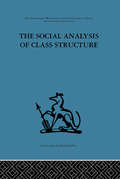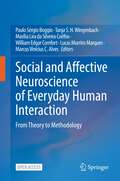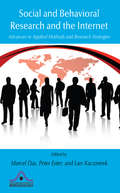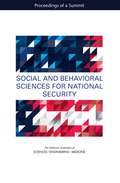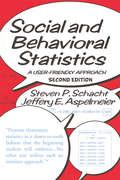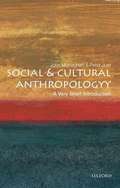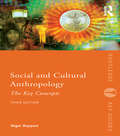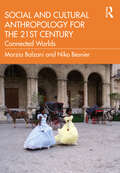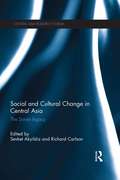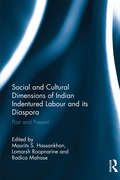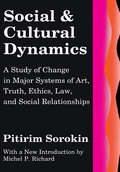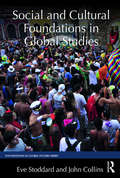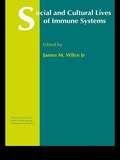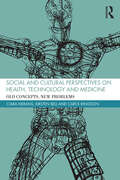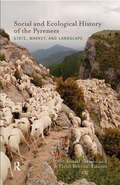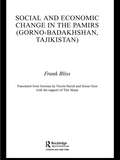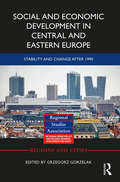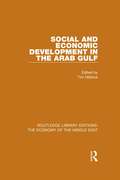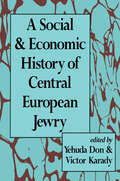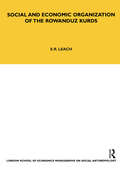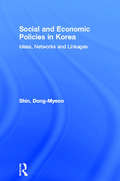- Table View
- List View
The Social Analysis of Class Structure (Routledge Library Editions: British Sociological Association Ser. #15)
by Frank ParkinTavistock Press was established as a co-operative venture between the Tavistock Institute and Routledge & Kegan Paul (RKP) in the 1950s to produce a series of major contributions across the social sciences. This volume is part of a 2001 reissue of a selection of those important works which have since gone out of print, or are difficult to locate. Published by Routledge, 112 volumes in total are being brought together under the name The International Behavioural and Social Sciences Library: Classics from the Tavistock Press. Reproduced here in facsimile, this volume was originally published in 1974 and is available individually. The collection is also available in a number of themed mini-sets of between 5 and 13 volumes, or as a complete collection.
Social and Academic Abilities in Children with High-Functioning Autism Spectrum Disorders
by Nirit Bauminger-ZvielyA uniquely comprehensive resource for practitioners, this research-based book addresses both the social-emotional and cognitive-academic challenges faced by children and adolescents with high-functioning autism spectrum disorders (HFASD). The author traces these kids' developmental trajectories and explores their distinct combination of strengths and needs. Effective school-based interventions for overcoming the social isolation and learning difficulties often associated with HFASD are reviewed in depth. Appendices include concise descriptions of more than 50 relevant assessment tools, plus a detailed, practical outline of the author's empirically supported social intervention model. E-book purchasers can download and print the tables from the Appendices at the companion Web page.
Social and Affective Neuroscience of Everyday Human Interaction: From Theory to Methodology
by Paulo Sérgio Boggio Tanja S. H. Wingenbach Marília Lira da Silveira Coêlho William Edgar Comfort Lucas Murrins Marques Marcus Vinicius C. AlvesThis Open Access book presents the current state of the art knowledge on social and affective neuroscience based on empirical findings. This volume is divided into several sections first guiding the reader through important theoretical topics within affective neuroscience, social neuroscience and moral emotions, and clinical neuroscience. Each chapter addresses everyday social interactions and various aspects of social interactions from a different angle taking the reader on a diverse journey. The last section of the book is of methodological nature. Basic information is presented for the reader to learn about common methodologies used in neuroscience alongside advanced input to deepen the understanding and usability of these methods in social and affective neuroscience for more experienced readers.
Social and Behavioral Research and the Internet: Advances in Applied Methods and Research Strategies (European Association of Methodology Series)
by Marcel Das, Peter Ester and Lars KaczmirekHighlighting the progress made by researchers in using Web-based surveys for data collection, this timely volume summarizes the experiences of leading behavioral and social scientists from Europe and the US who collected data using the Internet. Some chapters present theory, methodology, design, and implementation, while others focus on best practice examples and/or issues such as data quality and understanding paradata. A number of contributors applied innovative Web-based research methods to the LISS panel of CentERdata collected from over 5,000 Dutch households. Their findings are presented in the book. Some of the data is available on the book website. The book addresses practical issues such as data quality, how to reach difficult target groups, how to design a survey to maximize response, and ethical issues that need to be considered. Innovative applications such as the use of biomarkers and eye-tracking techniques are also explored. Part 1 provides an overview of Internet survey research including its methodologies, strengths, challenges, and best practices. Innovative ways to minimize sources of error are provided along with a review of mixed-mode designs, how to design a scientifically sound longitudinal panel and avoid sampling problems, and address ethical requirements in Web surveys. Part 2 focuses on advanced applications including the impact of visual design on the interpretability of survey questions, the impact survey usability has on respondents’ answers, design features that increase interaction, and how Internet surveys can be effectively used to study sensitive issues. Part 3 addresses data quality, sample selection, measurement and non-response error, and new applications for collecting online data. The issue of underrepresentation of certain groups in Internet research and the measures most effective at reducing it are also addressed. The book concludes with a discussion of the importance of paradata and the Web data collection process in general, followed by chapters with innovative experiments using eye-tracking techniques and biomarker data. This practical book appeals to practitioners from market survey research institutes and researchers in disciplines such as psychology, education, sociology, political science, health studies, marketing, economics, and business who use the Internet for data collection, but is also an ideal supplement for graduate and/or upper level undergraduate courses on (Internet) research methods and/or data collection taught in these fields.
Social and Behavioral Sciences for National Security: Proceedings of a Summit
by Engineering Medicine National Academies of SciencesIn the coming years, complex domestic and international environments and challenges to national security will continue. Intelligence analysts and the intelligence community will need access to the appropriate tools and developing knowledge about threats to national security in order to provide the best information to policy makers. Research and knowledge from the social and behavioral sciences (SBS) can help inform the work of intelligence analysis; however, in the past, bringing important findings from research to bear on the day-to-day work of intelligence analysis has been difficult. In order to understand how knowledge from science can be directed and applied to help the intelligence community fulfill its critical responsibilities, the National Academies of Sciences, Engineering, and Medicine will undertake a 2-year survey of the social and behavioral sciences. To launch this discussion, a summit designed to highlight cutting-edge research and identify future directions for research in a few areas of the social and behavioral sciences was held in October 2016. This publication summarizes the presentations and discussions from the summit.
Social and Behavioral Statistics: A User-Friendly Approach
by Steven P. SchachtRevised and updated to include the behavioral sciences, the second edition of this introductory statistics book engages students with real-world examples and exercises. To the dismay of many social and behavioral science majors, successfully passing a statistics course in sociology, psychology, and most other social/behavioral science programs is required, and at many institutions statistics is becoming a university-wide requirement. In this newly revised text, the authors continue to make use of their proven stress-busting approach to teaching statistics to self-describe math phobic students. This book uses humorous examples and step-by-step presentations of statistical procedures to illustrate what are often complex and hard-to-grasp statistical concepts. Students and instructors will find this text to be a helpful, easy to interpret and thoroughly comprehensive introduction to social and behavioral statistics. Perfect for social and behavioral sciences upper-level undergrads fearful of that required stats course. It uses stress-busting features like cartoons and real-world examples to illustrate what are often complex and hard-to-grasp statistical concepts. Includes the newest and most necessary tools for students to master statistical skills making handouts or additional books unnecessary and gives instructors and their students a compact and affordable main text for their introductory stats courses.
Social and Cultural Anthropology: A Very Short Introduction
by John Monagham Peter JustIf you want to know what anthropology is, look at what anthropologists do, write the authors of Social and Cultural Anthropology: A Very Short Introduction. This engaging overview of the field combines an accessible account of some of the discipline's guiding principles and methodology with abundant examples and illustrations of anthropologists at work. Peter Just and John Monaghan begin by discussing anthropology's most important contributions to modern thought: its investigation of culture as a distinctively human characteristic, its doctrine of cultural relativism, and its methodology of fieldwork and ethnography. Drawing on examples from their own fieldwork in Indonesia and Mesoamerica, they examine specific ways in which social and cultural anthropology have advanced our understanding of human society and culture. Including an assessment of anthropology's present position, and a look forward to its likely future, Social and Cultural Anthropology will make fascinating reading for anyone curious about this social science.
Social and Cultural Anthropology: The Key Concepts (Routledge Key Guides)
by Nigel RapportSocial and Cultural Anthropology: the Key Concepts is an easy to use A-Z guide to the central concepts that students are likely to encounter in this field. Now fully updated, this third edition includes entries on: Material Culture Environment Human Rights Hybridity Alterity Cosmopolitanism Ethnography Applied Anthropology Gender Cybernetics With full cross-referencing and revised further reading to point students towards the latest writings in Social and Cultural Anthropology, this is a superb reference resource for anyone studying or teaching in this area.
Social and Cultural Anthropology for the 21st Century: Connected Worlds
by Marzia Balzani Niko BesnierSocial and Cultural Anthropology for the 21st Century: Connected Worlds is a lively, accessible, and wide-ranging introduction to socio-cultural anthropology for undergraduate students. It draws on a wealth of ethnographic examples to showcase how anthropological fieldwork and analysis can help us understand the contemporary world in all its diversity and complexity. The book is addressed to a twenty-first-century readership of students who are encountering social and cultural anthropology for the first time. It provides an overview of the key debates and methods that have historically defined the discipline and of the approaches and questions that shape it today. In addition to classic research areas such as kinship, exchange, and religion, topics that are pressing concerns for our times are covered, such as climate change, economic crisis, social media, refugees, sexuality, and race. Foregrounding ethnographic stories from all over the world to illustrate global connections and their effects on local lives, the book combines a focus on history with urgent present-day social issues. It will equip students with the analytical tools that they need to negotiate a world characterized by unprecedented cross-cultural contact, ever-changing communicative technologies and new forms of uncertainty. The book is an essential resource for introductory courses in social and cultural anthropology and as a refresher for more advanced students.
Social and Cultural Anthropology in Perspective: Their Relevance in the Modern World
by Ioan LewisSocial anthropology is, in the classic definition, dedicated to the study of distant civilizations in their traditional and contemporary forms. But there is a larger aspiration: the comparative study of all human societies in the light of those challengingly unfamiliar beliefs and customs that expose our own ethnocentric limitations and put us in our place within the wider gamut of the world's civilizations. Thematically guided by social setting and cultural expression of identity, Social and Cultural Anthropology in Perspective is a dynamic and highly acclaimed introduction to the field of social anthropology, which also examines its links with cultural anthropology. A challenging new introduction critically surveys the latest trends, pointing to weaknesses as well as strengths.Presented in a clear, lively, and entertaining fashion, this volume offers a comprehensive and up-to-date guide to social anthropology for use by teachers and students. Skillfully weaving together theory and ethnographic data, author Ioan M. Lewis advocates an eclectic approach to anthropology. He combines the strengths of British structural-functionalism with the leading ideas of Marx, Freud, and Levi-Strauss while utilizing the methods of historians, political scientists, and psychologists. One of Lewis' particular concerns is to reveal how insights from ""traditional"" cultures illuminate what we take for granted in contemporary industrial and post-industrial society. He also shows how, in the pluralist world in which we live, those who study ""other"" cultures ultimately learn about themselves. Social anthropology is thus shown to be as relevant today as it has been in the past.
Social and Cultural Change in Central Asia: The Soviet Legacy (Central Asia Research Forum)
by Richard Carlson Sevket AkyildizFocusing on Soviet culture and its social ramifications both during the Soviet period and in the post-Soviet era, this book addresses important themes associated with Sovietisation and socialisation in the Central Asian states of Kazakhstan, Kyrgyzstan, Tajikistan, Turkmenistan, and Uzbekistan. The book contains contributions from scholars in a variety of disciplines, and looks at topics that have been somewhat marginalised in contemporary studies of Central Asia, including education, anthropology, music, literature and poetry, film, history and state-identity construction, and social transformation. It examines how the Soviet legacy affected the development of the republics in Central Asia, and how it continues to affect the society, culture and polity of the region. Although each state in Central Asia has increasingly developed its own way, the book shows that the states have in varying degrees retained the influence of the Soviet past, or else are busily establishing new political identities in reaction to their Soviet legacy, and in doing so laying claim to, re-defining, and reinventing pre-Soviet and Soviet images and narratives. Throwing new light and presenting alternate points of view on the question of the Soviet legacy in the Soviet Central Asian successor states, the book is of interest to academics in the field of Russian and Central Asian Studies.
Social and Cultural Dimensions of Indian Indentured Labour and its Diaspora: Past and Present
by Maurits S. Hassankhan Lomarsh Roopnarine Radica MahaseThis book is the third publication originating from the conference Legacy of Slavery and Indentured Labour: Past, present and future, which was organised in June 2013 by the Institute of Graduate Studies and Research (IGSR), Anton de Kom University of Suriname.
Social and Cultural Dynamics: A Study of Change in Major Systems of Art, Truth, Ethics, Law and Social Relationships (Extending Horizons Ser.)
by Pitirim SorokinThis classic work is a revised and abridged version, in a single volume, of the work which more than any other catapulted Pitirim Sorokin into being one of the most famed figures of twentieth-century sociology. Its original publication occurred before World War II. This revised version, written some twenty years later, reflects a postwar environment. Earlier than most, Sorokin took the consequences of the breakdown of colonialism into account in discussing the renaissance of the great cultures of African and Asian civilization. Other than perhaps F.S.C. Northrop, no individual better incorporated the new role of the Indian, Chinese, Japanese, and Arabic peoples in this postwar world. Sorokin came to view social and cultural dynamics in terms of three major processes: a major shift of mankind's creative center from Europe to the Pacific; a progressive disintegration of the sensate culture; and finally the first blush of the emergence and growth of a new idealistic sociocultural order. This volume is perhaps most famous for revealing Sorokin's remarkable efforts to understand the relationship of war and peace to the process of social and political change. Contrary to received wisdom, he shows that the magnitude and depth of war grows in periods of social, cultural, and territorial expansion by the nation. In short, war is just as often a function of development as it is of social decay. This long-unavailable volume remains one of the major touchstones by which we can judge efforts to create an international social science. There are few areas of social or cultural life that are not covered—from painting, art, and music, to the ethos of universalism and particularism. These are terms which Sorokin introduced into the literature long before the rise of functional doctrines. For all those interested in cultural and historical processes, this volume provides the essence of Sorokin's remarkably prescient effort to achieve sociological transcendence, by takin
Social and Cultural Foundations in Global Studies (Foundations in Global Studies)
by John Collins Eve StoddardFrom the Foundations in Global Studies series, this text offers students a fresh, comprehensive, multidisciplinary entry point to the study of the social and cultural aspects of global studies. After a brief introduction to global studies, the early chapters of the book survey the key concepts and processes of globalization as well as a critical look at the meaning and role globalization. Students are guided through the material with relevant maps, resource boxes, and text boxes that support and guide further independent exploration of the topics at hand. The second half of the book features interdisciplinary case studies, each of which focuses on a specific issue.
Social and Cultural Lives of Immune Systems (Theory and Practice in Medical Anthropology)
by James M. WilceSocial and Cultural Lives of Immune Systems introduces a provocative new hypothesis in medico-social theory - the theory that immunity and disease are in part socially constituted. It argues that immune systems function not just as biological entities but also as symbolic concepts charged with political significance. Bridging elements of psychology, sociology, body theory, immunology and medical anthropology, twelve papers from leading scholars explain some of the health-hazards of emotional and social pressure, whilst analysing the semiotic and social responses to the imagery of immunity.
Social and Cultural Perspectives on Health, Technology and Medicine: Old Concepts, New Problems
by Carol Kingdon Ciara Kierans Kirsten BellDevelopments in health, science and technology have long provided fertile analytical ground for social science disciplines. This book focuses on the critical and enduring importance of core concepts in anthropology and sociology for interrogating and keeping pace with developments in the life sciences. The authors consider how transformations in medical and scientific knowledge serve to reanimate older controversies, giving new life to debates about relations between society, culture, knowledge and individuals. They reflect on the particular legacies and ongoing relevance of concepts such as ‘culture’, ‘society’, ‘magic’, ‘production’, ‘kinship’, ‘exchange’ and ‘the body’. The chapters draw on the work of key historical and contemporary figures across the social sciences and include a range of illustrative case studies to explore topics such as transplant medicine, genetic counselling, cancer therapy, reproductive health and addiction. Of particular interest to students and scholars of anthropology, sociology, and science and technology studies, this volume will also be a valuable resource for those working in the fields of health and medicine.
Social and Ecological History of the Pyrenees: State, Market, and Landscape (New Frontiers in Historical Ecology #1)
by Ismael Vaccaro Oriol BeltranThis major work of historical ecology advances the integration of research on environmental and social systems, contributing important lessons for contemporary natural resource policy and management. A diverse, international region, the Pyrenees has been characterized as a quintessential example of rural areas across Europe and North America. The authors use qualitative and quantitative methods from economics, history, anthropology, and ecological science to integrate human agency and ecology across a landscape that moved from agricultural and pastoral production to industrialization, then experienced acute depopulation, and now is becoming a focus of conservation and tourism. The book shows how today’s most pressing resource policy challenges are best illuminated by this broad, long-term understanding of humans and landscapes.
Social and Economic Change in the Pamirs (Gorno-Badakhshan, Tajikistan): Translated from German by Nicola Pacult and Sonia Guss with support of Tim Sharp
by Frank BlissSince Olufsen and Schulz published their monographs on the Pamirs in 1904 and 1914, respectively, this is the first book to deal with the history, anthropology and recent social and economic development of the Pamiri people in Gorno-Badakhshan, Eastern Tajikistan. After the collapse of the Soviet Union, such high mountain areas were more or less forgotten and people would have suffered severely from their isolation if an Aga Khan Foundation project in 1993 to 1994 had not afforded broader support. The reader will be confronted by an almost surrealistic world: Pamiri income and living conditions after 1991 dropped to the level of a poor Sahelian country. Former scientists, university professors and engineers found themselves using ox-ploughs to plant potatoes and wheat for survival. On the other hand, 100% literacy and excellent skills proved to be an enormous human capital resource for economic recovery. The first sign of this was an increase in agricultural production, something that had never occurred during Soviet times.
Social and Economic Development in Central and Eastern Europe: Stability and Change after 1990 (Regions and Cities)
by Grzegorz GorzelakThe integration of post-socialist Central and Eastern Europe into the EU is one of the success stories of European development. The region has seen significant economic convergence, dramatic changes in socio-economic indicators and improvements in the natural environment. However, some challenges remain, such as political divergence, public governance issues and population demographics. This book identifies and analyses the key post-1990 developments across the New Member States at the sub-national and national levels, with frequent country-level and regional comparisons. Careful attention is paid to drawing out commonalities in development trajectories while appreciating each country’s unique context. Drawing on the academic literature and illuminating empirical material, the broad range of topics discussed in the book paints a detailed picture of both change and stability in Central and Eastern Europe. It will be valuable reading for advanced students, researchers and policymakers in regional studies, European studies, human geography, political economy and transition economics.
Social and Economic Development in the Arab Gulf (Routledge Library Editions: The Economy of the Middle East)
by Tim NiblockThe crucial importance of the Gulf region today – which may be defined as comprising the states of Saudi Arabia, Iraq, Kuwait, Oman, Bahrain, Qatar and the United Arab Emirates, with Iran as a non-Arab onlooker – has stimulated surprisingly little interest in academic circles. Much of what has been written, moreover, focuses exclusively on those aspects of direct concern to external interests. The focus of this book is on the Gulf region as an area with its own problems of social, economic and political development. It examines the dimensions of the attempts by the governments and peoples of the area to create new social, economic and political structures – stemming mainly, of course, from their new-found oil wealth. First published in 1980.
A Social and Economic History of Central European Jewry
by Peter J. KitsonThis volume is a pioneering effort to examine the social, demographic, and economic changes that befell the Jewish communities of Central Europe after the dissolution of the Habsburg Empire. It consists of studies researched and written especially for this volume by historians, sociologists, and economists, all specialists in modern Central European Jewish affairs.The era of national rivalry, economic crises, and political confusion between the two World Wars has been preceded by a pre-World War I epoch of Jewish emancipation and assimilation. During that period, Jewish minorities had been harbored from violent anti-Semitism by the Empire, and they became torchbearers of industrialization and modernization. This common destiny encouraged certain common characteristics in the three major components of the Empire, Austria, Hungary, and the Czech territories, despite the very different origins of the well over one million Jews in those three lands.The disintegration of the Habsburg Empire created three small, economically marginal national states, inimical to each other and at liberty to create their own policies toward Jews in accord with the preferences of their respective ruling classes. Active and openly discriminatory anti-Semitic measures resulted in Austria and Hungary. The only liberal heir country of the Empire was Czechoslovakia, although simmering anti-Semitism and below surface discrimination were widespread in Slovakia. While one might have expected Jewish communities to return to their pre-World War I tendencies to go their independent ways after the introduction of these policies, social and economic patterns which had evolved in the Habsburg era persisted until the Anschluss in Austria, German occupation in Czechoslovakia, and World War II in Hungary. Studies in this volume attest to continuing similarities among the three Jewish communities, testifying to the depth of the Empire's long lasting impact on the behavior of Jews in Central Europe.
Social and Economic Impact of Earth Sciences
by Vineet K. Gahalaut M. RajeevanThis book collects research papers on the economic and social impact of earth sciences. It covers topics related to weather forecasting, climate modelling, monsoon variability, air pollution, heat and cold wave, deep sea mineral and living resources, ocean state monitoring, tsunami and earthquake monitoring, desalination, coastal research, etc. The book focuses on the activities of the Ministry of Earth Sciences, India, in promoting the societal and economic impacts of earth science research in a simple language and in the form of stories and case studies, so that people with basic science degree can understand them.
Social and Economic Life in Second Temple Judea
by Samuel L. AdamsThose who study the Bible are becoming increasingly attentive to the significance of economics when examining ancient texts and the cultures that produced them. This book looks at the socioeconomic landscape of Second Temple Judea, from the end of the Babylonian exile to the destruction of the temple by the Romans (532 BCE to 70 CE). Adams carefully examines key themes, paying special attention to family life, the status of women, and children, while engaging relevant textual and archaeological evidence. He looks at borrowing and lending and the burdensome taxation policies under a succession of colonial powers. In this pursuit, Adams offers an innovative analysis of economic life with fresh insights from biblical texts. No other study has specifically analyzed economics for this lengthy timeframe, especially in relation to these key themes. This important book provides readers with a helpful context for understanding religious beliefs and practices in the time of early Judaism and emerging Christianity.
Social and Economic Organization of the Rowanduz Kurds
by Edmund LeachInitially published in 1940, the following account is based upon a five weeks field survey carried out during the summer of 1938 in Iraq. The author intended to follow this up with an intensive study of one locality over a period of twelve months. Political developments in Europe made this project impracticable at the time and the scheme was abandoned.
Social and Economic Policies in Korea: Ideas, Networks and Linkages (Routledge Advances in Korean Studies)
by Dong-Myeon ShinThe sustained remarkable economic growth in the East Asian countries - Japan, South Korea, Taiwan, Hong Kong and Singapore - has brought about a great deal of debate over the role of the state in the market and society. Shin analyses the dynamic process of state interventions in the economy and social affairs in Korea from the early 1960s until the present with special reference to five policy areas: macro-economic policy, industrial policy, social security policy, labour policy, and education and training policy.Social and Economic Policies in Korea develops a unique explanation about the development of Korean social policy using the concepts of 'policy idea', 'policy network', and 'policy-linkages' to examine the causes, patterns and consequences of state interventions in the economy and social affairs over time. It should interest students and researchers of East Asian studies, social policy and development studies.
